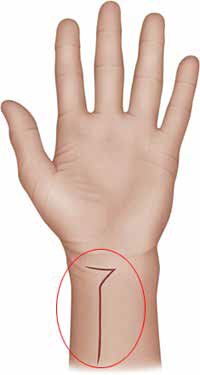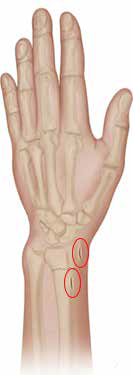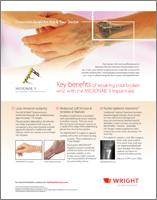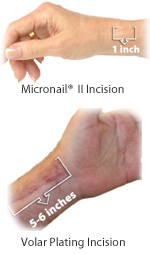MICRONAIL™ Fixation

Key Benefits
- Less-invasive surgery compared to traditional volor plating surgeries
- Smaller incisions, resulting in smaller scars
- Less trauma to surrounding tissue
A new way to treat Wrist Breaks resulting in less scarring & faster recovery than traditional treatment options.*
The wrist is the most commonly broken bone in the human body. It’s a natural reaction, when we fall, to put our hands out to catch ourselves and … ouch … that’s when most wrist breaks occur.
Approximately 300,000 people are treated each year in the U.S., alone. Yet, the standard of care for this type of break hasn’t changed for decades. Until now.
If you are researching surgical options online, you (or someone you love) may have recently suffered a traumatic event – in which the wrist has been broken and is now stabilized. Or, perhaps you (or someone you love) are faced with a revision surgery (second surgery) to readdress the break.
You may be looking for the surgical choices that are available to you. Or, perhaps a single option has been explained to you and you are wondering if there is an alternative treatment that may be available to you.
That’s why we, at Wright, have developed this website. We invite you to read more about Wright’s MICRONAIL™ Fixation implant. It’s a new and unique treatment for repairing broken wrists.
The surgical technique used by surgeons to implant this product uses smaller incisions, which disturbs less soft tissue during your surgery. That can lead to less pain and faster recovery after surgery along with smaller, less obtrusive scars.
*Data on file. As compared to volar plates at 6 months.

Faster Recovery: Traditional treatment options that involve inserting a metal plate on top of the broken wrist bone and fixing it with screws require a larger incision and may not provide the desired level of flexibility / wrist function as quickly as the MICRONAIL™ Fixation implant can. The longer it takes to start moving the wrist, the slower the recovery. Stiffness and limited range of motion may require rehabilitation with a hand therapist. It is important to start moving the fingers, hand, and wrist as quickly as possible.
Few patients require a cast after surgery and most only wear a splint for a day. Also, most patients do not require professional hand therapy following the surgery due to the ability to start motion almost immediately. This recovery allows patients to return to normal activities such as personal hygiene, cooking, driving, work, etc. (Source: CORR, April 2006).

Minimally-invasive Surgery: The MICRONAIL™ Fixation implant is placed completely inside the bone during surgery through 2 very small incisions that are much smaller than traditional plating devices require. Smaller incisions and the minimally-invasive approach to implant the MICRONAIL™ Fixation implant disturbs less soft tissue which contributes to a quicker recovery. The minimal incisions allow the patient to move his/her wrist, hand, and fingers in a relatively short period of time.
In addition, placing the implant inside the bone provides immediate stability to the break while minimizing the possibility of irritation to surrounding soft tissue.


Less Scarring: Traditional plating systems typically require a large 5-6 inch incision. Conversely, the MICRONAIL™ Fixation implant requires only two small 1-inch incisions – thereby, allowing for a minimally-invasive approach to surgery resulting not only in faster, less painful recovery; but less obtrusive scars as well.
Less Post-operative Irritation: Also, contrary to traditional plating systems, the MICRONAIL™ Fixation device is housed completely within the bone, not on top … which provides stability to the broken bone while minimizing the possibility of irritation to surrounding tissue. When treated by a traditional metal plate, which is screwed on top of the broken bone, tendons rubbing on top of that metal plate can cause irritation and rupture. Irritated tissue causes pain and discomfort.
Individual results may vary.
Compare Incision Size
Volor Plating
This surgical procedure requires a larger incision (typically a 5-6 inch incision).

MICRONAIL™ Fixation
The MICRONAIL™ Fixation implant is placed completely inside the bone during surgery through 2 very small incisions.

Discussion Guide For You & Doctor



Your doctor is the most qualified person to determine the best treatments for your broken wrist. But, if your wrist requires surgery and you would like to discuss the benefits of MICRONAIL™ Intramedullary Distal Radius Fixation with your surgeon, please print this information and bring it to your next appointment.
Key benefits of repairing your broken wrist with the MICRONAIL™ II Implant are:
Less-invasive surgery: The procedure helps to preserve soft tissue, as compared to the more invasive surgical approach related to traditional volar plating, which can require a much larger 5-6″ incision.
Having the MICRONAIL™ implant housed completely within the bone, not on top, provides stability to the broken bone while minimizing the possibility of irritation to surrounding tissue.
Faster patient recovery*: Traditional “plating” treatment options require a larger incision which results in more soft tissue damage and may not provide the desired level of flexibility / wrist function as quickly as MICRONAIL™ Fixation. Generally, the longer it takes a patient to start moving his or her wrist, the slower the recovery.
Few patients require a cast after surgery. Most only wear a splint for a short time, and may not require professional hand therapy. This allows patients to return to normal activities quickly. (Source: CORR, April 2006)
*Data on file. As compared to volar plates at 6 months.

